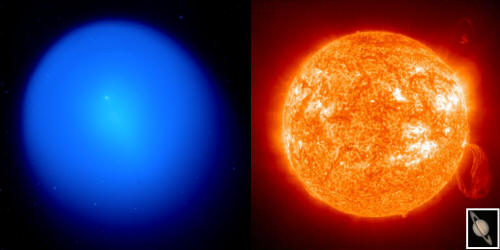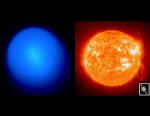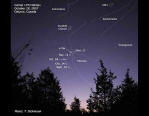|

by David Jewitt
Spanish version
Last updated 09 Nov 2007
from
DavidJewitt Website
Summary
Formerly, the Sun was the largest object in the Solar System. Now,
comet 17P/Holmes holds that distinction.
Spectacular out-bursting comet 17P/Holmes exploded in size and
brightness on October 24. It continues to expand and is now the
largest single object in the Solar system, being bigger than the Sun
(see below figure). The diameter of the tenuous dust atmosphere of the
comet was measured at 1.4 million kilometers (0.9 million miles) on
2007 November 9 by Rachel Stevenson, Jan Kleyna and
Pedro Lacerda of the University of Hawaii Institute for
Astronomy.
They used observations from a wide-field
camera on the Canada-France-Hawaii Telescope (CFHT),
one of the few professional instruments still capable of capturing
the whole comet in one image. Other astronomers involved in the UH
program to study the comet include Bin Yang, Nuno Peixinho and David
Jewitt.
The present eruption of comet Holmes was
first reported on October 24 and has continued at a steady 0.5
km/sec (1100 mph) ever since. The comet is an unprecedented half a
million times brighter than before the eruption began.
This amazing eruption of the comet is
produced by dust ejected from a tiny solid nucleus made of ice and
rock, only 3.6 km (roughly 2.2 miles) in diameter.

Caption:
(Left)
Image of comet Holmes from the 3.6-meter Canada-France-Hawaii
telescope on Mauna Kea showing the 1.4 million km diameter coma.
The white ''star'' near the center of the coma is in fact the
dust-shrouded nucleus.
(Right)
the Sun and planet Saturn shown at the same scale for
comparison. (Sun and Saturn images courtesy of ESA/NASA's SOHO
and Voyager projects).
The new image also shows the growth of a
tail on comet Holmes (the fuzzy region to the lower right in the
comet picture), caused by the pressure of sunlight acting on dust
grains in the coma. Over the next few weeks and months, the coma and
tail are expected to expand even more while the comet will fade as
the dust disperses. Comet Holmes showed a double outburst in
November 1892 and January 1893.
It is not known if the present activity
in the comet will follow the pattern from 1892, but continued
observations from Mauna Kea are planned to watch for a second
outburst. Most comets show small fluctuations in brightness and some
have distinct outbursts. The huge event on-going in comet Holmes is
unprecedented, however.
The orbit period of comet Holmes is about 6 years, putting it in the
class of Jupiter Family Comets whose orbits are strongly influenced
by Jupiter. These objects are thought to have spent most of the last
4.5 billion years orbiting the Sun beyond Neptune, in a region known
as
the Kuiper Belt. Holmes probably
was deflected into its present orbit within the last few thousand
years and is losing mass as it evaporates in the heat of the Sun.
In another few thousand years it is
likely either to hit the Sun or a planet, be ejected from the Solar
system, or simply die by running out of gas.
Contacts
More from FOX News
from
FoxNews Website
A comet that has delighted backyard astronomers in recent weeks
after an unexpected eruption has now grown larger than the sun. The
sun remains by far the most massive object in the solar system, with
an extended influence of particles that reaches all the planets. But
the comparatively tiny Comet Holmes has released so much gas and
dust that its extended atmosphere, or coma, is larger than the
diameter of the sun.
The comparison is clear in a new image.
"It continues to expand and is now
the largest single object in the solar system," according to
astronomers at the University of Hawaii.
The coma's diameter on Nov. 9 was
869,900 miles (1.4 million kilometers), based on measurements by
Rachel Stevenson, Jan Kleyna and Pedro Lacerda of the University of
Hawaii Institute for Astronomy.
They used observations from the
Canada-France-Hawaii Telescope.
|
 |
 |
 |
 |
 |
|
University
of Hawaii/CFHT (comet); NASA/Voyager (Saturn); NASA/ESA/SOHO
(sun)Comet Holmes, the Sun and Saturn at all about the
same scale.
|
NASA,ESA,
and H. Weaver (The Johns Hopkins University Applied
Physics Laboratory); Alan DyerAmateur astronomer photo,
left, shows Holmes with a faint tail; Hubble image,
right, reveals bow-tie pattern created by dust. |
NASA/ESA/T.
Dickinson, Ontario, CanadaThe location of Comet Holmes
on various dates is superimposed on this amateur
astronomer's image.
|
Percy
MuiOct. 27: Comet Holmes, captured in a 2-minute
exposure taken by Percy Mui from the Karl G. Henize
Observatory at Harper College in Palatine, Ill.
|
Arkansas
Sky Observatories/Clay SherrodOct. 25: The usually dim
Comet 17P Holmes blazes away in an image from the
Harvard MPC H45 observatory at Petit Jean Mountain in
Arkansas. |
The sun's diameter, stated differently
by various sources and usually rounded to the nearest 100, is about
864,900 miles (1.392 million kilometers). Separately, a new Hubble
Space Telescope photo of the comet reveals an intriguing bow-tie
structure around its nucleus.
The comet's coma — mostly microscopic particles — shines by
reflecting sunlight.
See for yourself
Holmes is still visible to the naked eye as a fuzzy star any time
after dark, high in the northeastern sky. It is faintly visible from
cities, and from dark country locations is truly remarkable.
"Right now, in a dark sky it appears
as a very noticeable circular cloud," said Joe Rao, SPACE.com's
Skywatching Columnist.
Rao advises looking for the comet this
weekend, before the moon becomes more of a factor. The comet will
likely diminish in brightness yet remain visible for the next two to
three weeks, he said.
"Over the next few weeks and months,
the coma and tail are expected to expand even more while the
comet will fade as the dust disperses," Stevenson and her
colleagues write.
On Monday, Nov. 19, the comet will
create a unique skywatching event with its see-through coma,
according to the Web site
Spaceweather.com:
"The comet will glide by the star
Mirfak [also called Alpha Persei] and appear to swallow it — a
sight not to be missed."
A small telescope will reveal the fuzzy
coma. Lacking a long tail characteristic of some great comets,
however, Holmes is not the most dramatic object in the sky for
casual observers.
Mystery outburst
Nobody knows why Holmes erupted, but it underwent a similar
explosive brightening in 1892. The recent display, which began Oct.
24, brought the comet from visual obscurity to being one of the
brighter objects in the night sky. It has since dimmed somewhat as
the material races outward from the nucleus at roughly 1,100 mph
(0.5 km/sec).
The Hawaiian astronomy team writes in a press statement:
"This amazing eruption of the comet
is produced by dust ejected from a tiny solid nucleus made of
ice and rock, only 3.6 kilometers (roughly 2.2 miles) in
diameter."
The new image from the Hawaiian
observatory also shows a modest tail forming to one side, now just a
fuzzy region to the lower-right. That's caused by the pressure of
sunlight pushing on the gas and dust of the coma. But the comet is
so far away - 149 million miles (240 million kilometers), or about
1.6 times the distance from Earth to the Sun - that even Hubble
can't resolve its nucleus.
The offset nature of the coma, seen in ground-based images, suggests,
"a large fragment broke off and subsequently disintegrated into tiny
dust particles after moving away from the main nucleus," Hubble
astronomers said in a statement Thursday.
The comet's distance, plus all the dust, prevent Hubble from seeing
any fragments, however.
|






